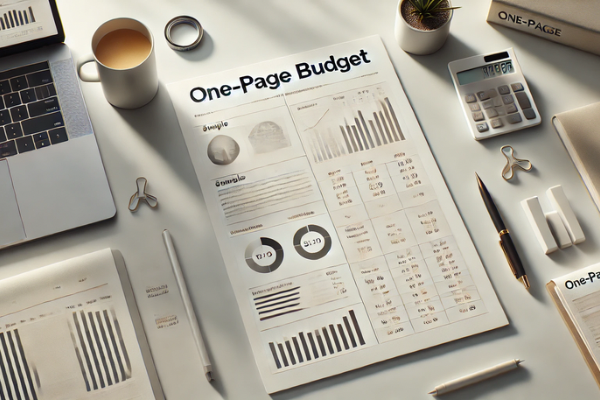Managing your personal finances doesn’t need to be complicated. In fact, one of the most effective ways to take control of your money is to simplify it. That’s where the concept of a one-page budget comes in. Instead of juggling multiple apps, spreadsheets, and tracking systems, a one-page budget gives you a clear, concise overview of your entire financial life — all in one place.
This minimalist approach is perfect for beginners, busy professionals, or anyone feeling overwhelmed by financial complexity. In this article, you’ll learn how to create a one-page budget, why it works, and how it can help you gain clarity, confidence, and control over your finances.
What Is a One-Page Budget?
A one-page budget is exactly what it sounds like — a simple, condensed budget that fits on a single page. It includes your income, savings, fixed expenses, variable expenses, and financial goals. The goal is to capture the essentials without the clutter.
This method works because it removes distractions and focuses your attention on what really matters. Instead of micromanaging every penny, you focus on high-level categories and spending patterns. That makes it easier to stay on track and make smarter money decisions.
Benefits of a One-Page Budget
- Clarity: You can see your entire financial picture at a glance.
- Simplicity: Less detail means less stress and a higher chance of sticking with it.
- Efficiency: Updating your budget takes minutes instead of hours.
- Flexibility: It can be adapted to different income levels and lifestyles.
Whether you’re saving for a goal, trying to break free from paycheck-to-paycheck living, or just want more peace of mind, a one-page budget can help you get there.
Step 1: Identify Your Monthly Income
Start your budget by listing your total monthly income. This includes your salary, side hustle earnings, freelance income, or any other reliable source of money you receive on a monthly basis. Always use your net income — the amount you take home after taxes and deductions.
Example:
- Primary job: $3,500
- Freelance income: $500
- Total monthly income: $4,000
Step 2: List Your Fixed Expenses
Next, list your fixed expenses — these are the bills that don’t change from month to month. Examples include:
- Rent or mortgage
- Utilities (average monthly total)
- Internet
- Phone bill
- Insurance premiums
- Loan or debt payments
- Subscriptions (Netflix, gym, etc.)
Total these expenses to see how much of your income is already spoken for.
Step 3: Estimate Your Variable Expenses
Variable expenses change from month to month. These include categories such as:
- Groceries
- Dining out
- Gas or transportation
- Clothing
- Entertainment
- Personal care
Estimate average amounts based on your past spending. It’s okay if they’re not exact — the purpose is to create a realistic, workable estimate that helps guide your decisions.
Step 4: Include Savings and Financial Goals
Now it’s time to include your savings targets and financial goals. This is a key part of the one-page budget because it shifts your focus from just spending to building your future.
- Emergency fund contribution
- Retirement savings
- Debt payoff
- Vacation fund or big purchase
Decide how much you want to allocate to each goal. Even if the amounts are small, consistency is more important than size. The point is to be intentional and build positive habits.
Step 5: Calculate the Totals
Now that you’ve listed income, fixed expenses, variable expenses, and savings goals, it’s time to do the math:
- Total Income – (Fixed Expenses + Variable Expenses + Savings) = Remaining Balance
If you have money left over, you can increase your savings, make extra debt payments, or enjoy a bit more flexibility. If you’re in the negative, look at where you can cut back — especially in variable expenses or non-essential subscriptions.
Step 6: Put It All on One Page
Now consolidate everything into a single-page layout. You can do this on paper, in a digital document, or in a spreadsheet. The layout can be simple:
- Monthly Income: $4,000
- Fixed Expenses: $2,000
- Variable Expenses: $1,200
- Savings/Goals: $600
- Remaining: $200
You can use categories, color coding, or charts if you like — but the most important thing is that it’s easy to read and update. Keep it visible and review it regularly.
Tips for Success with a One-Page Budget
- Review weekly: Check your progress and make small adjustments as needed.
- Be realistic: Don’t underestimate expenses or overestimate income. Honesty leads to better outcomes.
- Stay flexible: Life changes — your budget should evolve with it.
- Automate what you can: Set up automatic savings or bill payments to stay on track.
- Celebrate progress: Even small wins like paying off a bill or hitting a savings target deserve recognition.
Final Thoughts: Clarity Over Complexity
You don’t need a complicated system to manage your money effectively. In fact, simplicity often leads to more consistent habits and better financial outcomes. A one-page budget gives you the clarity and focus needed to stay in control of your finances, make smarter decisions, and move toward your goals with confidence.
Take the time to set up your one-page budget today — and start enjoying the peace of mind that comes with a simplified financial life.
